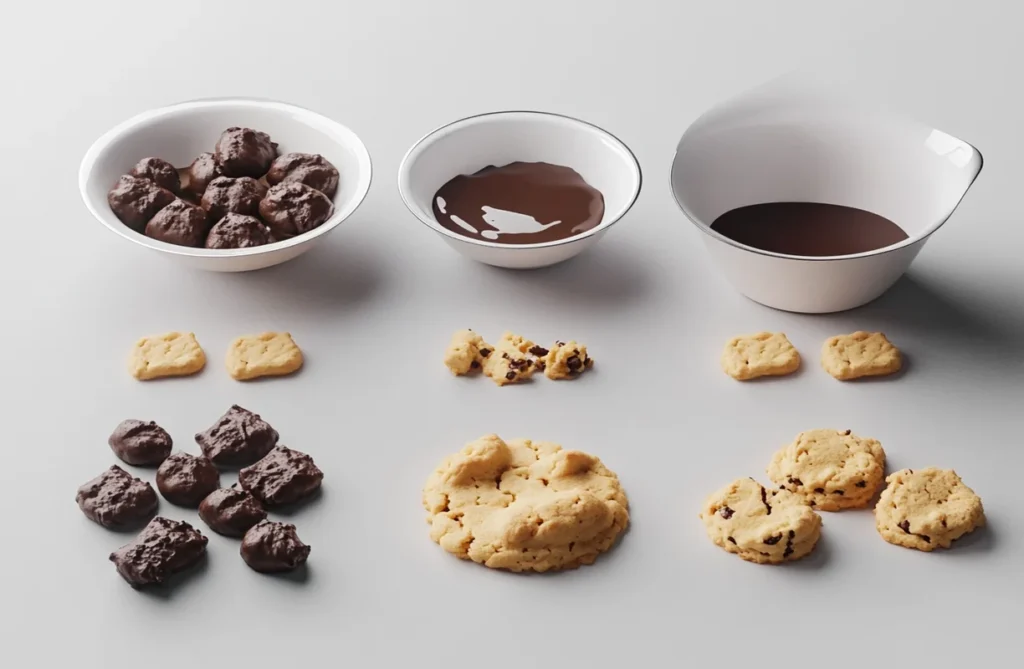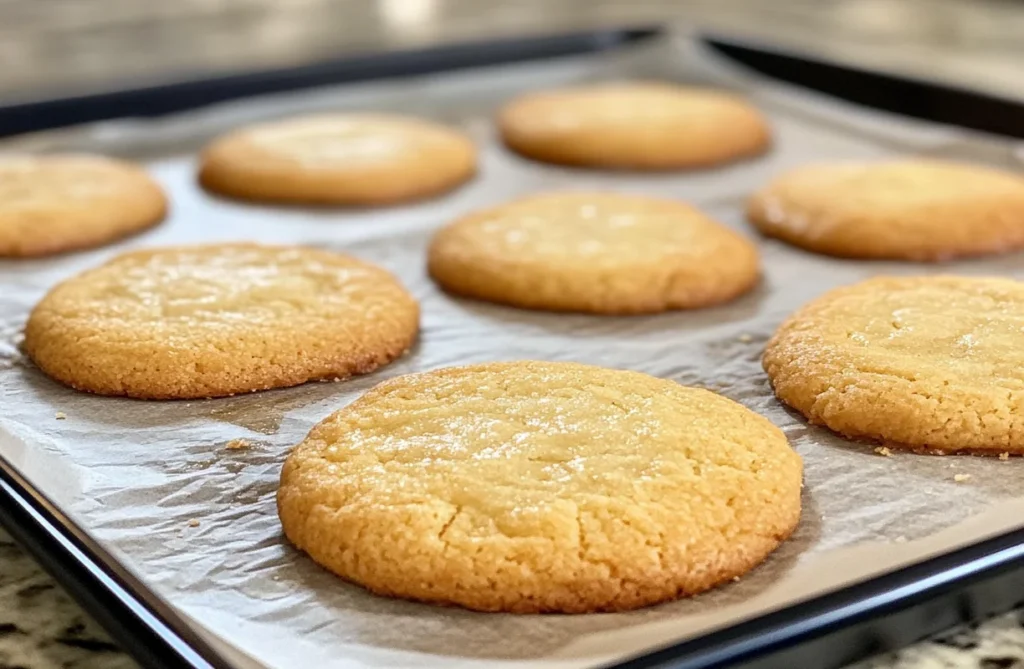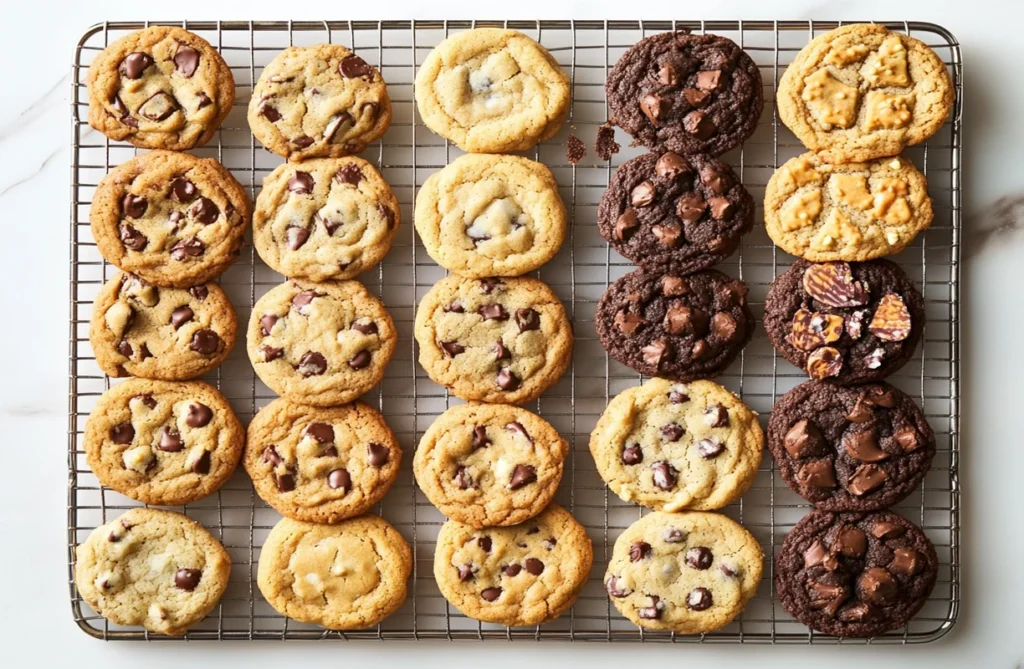When it comes to baking cookies, the oven temperature plays a crucial role in determining their texture, flavor, and overall quality. So, is it better to bake cookies at 350 or 375 degrees? The answer lies in what you’re looking for in a cookie. While 350°F ensures a softer, chewier cookie, 375°F tends to produce a slightly crispier result with a golden finish. Understanding how these temperatures impact the baking process will help you achieve cookie perfection every time.
Whether you’re a seasoned baker or a beginner, this guide will explore the science behind cookie baking, including how to Bake Cookies at 350 or 375, and offer practical tips for choosing the best temperature based on your preferences. Ready to dive into the delicious world of baking and discover how to Bake Cookies at 350 or 375 for perfect results?
The Science of Cookie Baking
When it comes to baking cookies, the temperature of your oven sets the stage for a series of chemical reactions that transform raw dough into delicious treats. Let’s take a closer look at the science behind cookie baking and why temperature matters so much.
The Science of Cookie Baking
Baking cookies is not just about throwing dough into the oven; it’s a finely balanced chemical process. Here’s what happens when you bake cookies and how temperature plays a crucial role:
- Butter Melting: As the oven heats up, the butter in your cookie dough begins to melt. This causes the dough to spread and form its signature shape. The temperature you choose determines how quickly this happens—at 375°F, the process is faster, creating slightly thinner, crispier cookies.
- Sugar Caramelization: Sugar starts to caramelize at around 356°F, giving cookies their golden color and rich flavor. Baking at 350°F gives the sugar more time to caramelize evenly, while 375°F speeds up the process, producing deeper browning on the edges.
- Protein Coagulation: The proteins in eggs and flour set as the cookies bake, providing structure. Baking at a higher temperature (375°F) accelerates this, often leading to cookies with a crispy exterior and softer interior.
- Maillard Reaction: This reaction between amino acids and sugars creates complex flavors and a beautiful golden-brown hue. Both 350°F and 375°F facilitate this reaction, but the higher temperature produces more pronounced results.
Why Temperature Control Matters
The oven temperature you choose affects every stage of the baking process. For instance:
- At 350°F: Cookies bake more slowly, allowing for an even distribution of heat. This results in a softer, chewier texture with a balanced flavor profile.
- At 375°F: The faster bake time can create cookies that are crisp around the edges but still gooey in the center, making them ideal for those who love a bit of crunch.

Experimenting with Temperature
If you’re unsure which temperature to use, consider baking a test batch. To get started, Bake Cookies at 350 or 375 by dividing the dough and baking half at 350°F and the other half at 375°F. Next, compare the texture, flavor, and appearance of each batch to decide what best suits your taste. This way, you’ll not only discover the differences but also gain a deeper understanding of how temperature impacts your cookies. Ultimately, this hands-on approach to Bake Cookies at 350 or 375 will enhance your baking skills and confidence. This hands-on approach to Bake Cookies at 350 or 375 not only helps you understand the impact of temperature but also improves your baking skills.
Baking Cookies at 350 Degrees
1. The Benefits of Baking at 350°F
- Even Heat Distribution: At 350°F, the heat penetrates the cookie dough more gradually. This slower process allows the cookies to spread evenly and bake uniformly, which is especially helpful for larger batches.
- Chewy Texture: The slower baking process prevents the cookies from drying out. The interior remains soft and chewy, making this temperature perfect for those who prefer tender cookies.
- Balanced Flavor: A lower temperature gives sugar more time to caramelize slowly, creating a rich, balanced sweetness.
2. How Cookies Turn Out at 350°F
Cookies baked at 350°F are typically:
- Lightly golden on the edges.
- Soft and chewy in the center.
- Consistent in texture, with a smooth surface.
3. Best Cookie Types for 350°F
Certain cookies perform best at 350°F, such as:
- Chocolate Chip Cookies: They retain a soft interior and slightly crisp edges.
- Oatmeal Raisin Cookies: The slower baking allows oats to soften, yielding a more cohesive bite.
- Sugar Cookies: These cookies bake evenly, making them ideal for decorating later.
Pro Tips for Baking at 350°F
- Rotate Your Trays: Even at 350°F, hot spots in your oven can lead to uneven baking. Rotate your cookie trays halfway through for consistent results.
- Chill Your Dough: If you want to prevent excessive spreading, refrigerate the dough for at least 30 minutes before baking. This is particularly useful for butter-rich recipes.
- Watch the Timer: Cookies baked at 350°F generally take 10-12 minutes, but keep an eye on them to avoid overbaking.
Potential Drawbacks of 350°F
While 350°F is a reliable temperature, it may not be ideal for every scenario. Some bakers find that:
- The cookies take slightly longer to bake, which can lead to underbaked centers if you’re not careful.
- If you’re looking for crispy cookies, 350°F might not achieve the desired crunch.
Experimenting with 350°F
If you’re new to baking cookies, it’s best to start at 350°F to master the basics. In fact, this temperature is forgiving, making it easier for beginners to achieve consistent results. Moreover, it works well across a variety of recipes, allowing you to build confidence before experimenting with other temperatures. Once you’ve perfected your technique, you can experiment with higher temperatures to achieve different textures.
Baking Cookies at 375 Degrees
Baking cookies at 375°F introduces a different set of characteristics to your cookies, ideal for those who enjoy crispier edges and a golden-brown finish. This slightly higher temperature shortens the baking time and intensifies the Maillard reaction, resulting in cookies that are as visually appealing as they are delicious.
Baking Cookies at 375 Degrees
1. The Benefits of Baking at 375°F
- Crispier Edges: The increased heat causes the outer layer of the cookie to set quickly, creating a firm, slightly crunchy texture around the edges.
- Golden Color: Higher heat enhances the Maillard reaction and sugar caramelization, leading to a deeper, richer color and flavor.
- Quicker Baking: Cookies bake in less time at 375°F—typically 8-10 minutes—making it a great choice when you need cookies in a hurry.
2. How Cookies Turn Out at 375°F
Cookies baked at 375°F tend to be:
- Crisp and golden on the outside.
- Soft and gooey in the middle (if baked for a slightly shorter time).
- More prone to spreading, resulting in thinner cookies.
3. Best Cookie Types for 375°F
Cookies that thrive at this temperature include:
- Peanut Butter Cookies: The faster baking time preserves their moisture while ensuring crispy edges.
- Snickerdoodles: The higher heat accentuates the cinnamon-sugar coating, creating a delectable crust.
- Shortbread Cookies: These cookies benefit from the rich, golden hue achieved at 375°F.
Pro Tips for Baking at 375°F
- Use Parchment Paper: Higher heat increases the risk of cookies sticking to the tray. Line your baking sheet with parchment paper or a silicone mat for easy removal.
- Keep Dough Chilled: To avoid over-spreading, keep the dough cold. Warmer dough tends to flatten too quickly at 375°F.
- Check Frequently: Cookies bake quickly at this temperature. Begin checking for doneness around the 8-minute mark to avoid burning.
Potential Drawbacks of 375°F
While 375°F offers several advantages, it may not be the best choice for every recipe or preference:
- Cookies may spread too thin, especially if the dough isn’t properly chilled.
- The higher heat can cause cookies to overbrown or burn quickly if you’re not attentive.
- Some delicate cookies, like those with intricate shapes or designs, may not hold up as well.

Experimenting with 375°F
For experienced bakers, 375°F is an excellent temperature to experiment with for achieving bold flavors and textures. If you’re baking in smaller batches or want more pronounced crispiness, this temperature is worth exploring.
Comparing 350°F vs. 375°F: Key Factors
Choosing between 350°F and 375°F for baking cookies boils down to personal preference and the type of cookie you’re making. Each temperature brings unique characteristics to the final product, and understanding these differences can help you decide which is right for your recipe.
Comparing 350°F vs. 375°F: Key Factors
1. Texture
- 350°F: Produces cookies with a soft, chewy texture. The slower baking time allows the interior to set gradually, resulting in a tender bite.
- 375°F: Creates cookies with crisp edges and a slightly drier texture, ideal for those who prefer a crunchier cookie.
2. Color
- 350°F: Yields a lighter, more uniform color. This temperature is perfect for cookies that need to maintain a delicate appearance, like sugar cookies or thumbprints.
- 375°F: Encourages a golden-brown hue with deeper caramelization, giving cookies a rustic, homemade look.
3. Flavor
- 350°F: Allows flavors to develop more gradually, producing a balanced sweetness and subtler nuances.
- 375°F: Enhances the Maillard reaction, intensifying the caramelized and nutty flavors for a bolder taste.
4. Baking Time
- 350°F: Typically takes 10-12 minutes, giving the dough more time to spread and set evenly.
- 375°F: Shortens the baking time to 8-10 minutes, which can be an advantage when baking multiple batches.
5. Spread
- 350°F: Cookies spread less as the dough warms more slowly, resulting in thicker cookies with a denser texture.
- 375°F: The higher heat melts the butter faster, causing cookies to spread more and creating a thinner, crispier result.
Which Temperature Works Best for You?
Choose 350°F if you prefer:
- Chewy cookies with a soft interior.
- Even baking for a consistent texture.
- A longer window to check for doneness.
Choose 375°F if you prefer:
- Crispier cookies with golden edges.
- A faster bake time for quicker results.
- Deeper, caramelized flavors.
Side-by-Side Comparison Table
| Key Factor | 350°F | 375°F |
|---|---|---|
| Texture | Soft and chewy | Crisp edges, drier |
| Color | Lighter and uniform | Golden-brown, rustic |
| Flavor | Subtle and balanced | Bold and caramelized |
| Baking Time | 10-12 minutes | 8-10 minutes |
| Cookie Spread | Thicker and denser | Thinner and crispier |
Experimentation Is Key
To truly discover your favorite cookie style, try baking a test batch at both temperatures. This hands-on comparison will give you insight into how each temperature influences the final result, allowing you to tweak recipes for your ideal cookie.
Cookie Type and Temperature Choice
The type of cookie you’re baking plays a significant role in determining the best oven temperature. While some cookies thrive at the moderate heat of 350°F, others shine with the quicker bake and crispier results of 375°F. Understanding how different doughs and ingredients respond to heat will help you make the perfect choice.
Cookie Type and Temperature Choice
1. Chewy Cookies
Chewy cookies, like chocolate chip or oatmeal raisin, benefit from the slower baking process at 350°F.
- Why It Works: Baking at 350°F allows the dough to set gradually, creating a soft, moist interior.
- Best Examples: Chocolate chip cookies, oatmeal cookies, molasses cookies.
- Pro Tip: To enhance chewiness, chill the dough before baking and ensure it contains enough moisture (from eggs or molasses).
2. Crisp Cookies
For cookies like gingersnaps or shortbread, 375°F is often the preferred temperature.
- Why It Works: The higher heat quickly sets the edges, creating a satisfying crunch.
- Best Examples: Shortbread cookies, sugar cookies with crispy edges, gingersnaps.
- Pro Tip: Roll the dough thinner and bake for slightly longer to maximize crispiness.
3. Decorated Cookies
For cookies that will be decorated, such as sugar cookies or gingerbread men, 350°F is usually best.
- Why It Works: The slower baking process helps the cookies maintain their shape, making them ideal for icing and decorating.
- Best Examples: Sugar cookies, gingerbread, thumbprints.
- Pro Tip: Place the dough in the freezer for 10 minutes before baking to reduce spreading.
4. Large, Bakery-Style Cookies
If you love oversized cookies with gooey centers and crispy edges, 375°F delivers the best results.
- Why It Works: The high heat bakes the outer layer quickly while leaving the inside soft and gooey.
- Best Examples: Jumbo chocolate chip cookies, stuffed cookies (like Nutella-filled or cookie sandwiches).
- Pro Tip: Increase the dough ball size to ensure the center remains soft even with the shorter bake time.
Experimenting with Hybrid Baking
Some bakers find success by combining temperatures. For example:
- Start baking at 375°F for 3-4 minutes to set the edges quickly.
- Lower the temperature to 350°F to allow the interior to bake evenly.
This technique offers the best of both worlds—crispy exteriors and chewy centers.
Adapting to Altitude and Humidity
- High Altitudes: Reduce baking temperature by 15-20°F and extend the bake time slightly. Higher altitudes cause dough to rise faster, so a lower temperature ensures even baking.
- Humid Environments: Use 375°F to combat the added moisture in the air, which can soften cookies during baking.

Key Takeaways
Matching the temperature to the cookie type can dramatically improve your baking results. Chewy cookie fans will appreciate the even baking at 350°F, while crisp lovers will adore the golden results from 375°F. With a little experimentation, you can customize the bake to suit any recipe or preference. For more inspiration, check out this guide on Disney Chocolate Chip Cookies.
FAQs About Cookie Baking
What is Jacques Torres’ famous recipe?
Jacques Torres, also known as “Mr. Chocolate,” is renowned for his famous chocolate chip cookie recipe. His cookies are known for their exceptional flavor and texture, achieved through a few key techniques:
- Ingredients: High-quality chocolate disks or chunks, a blend of bread flour and cake flour, and unsalted butter.
- Secret Techniques: Chilling the dough for 24 to 72 hours before baking, which allows the flavors to develop and creates a chewier texture.
- Baking Tip: Torres bakes his cookies at 350°F for an even, consistent result.
What is the secret ingredient to keep cookies soft?
The secret ingredient for keeping cookies soft is moisture-retaining components, such as:
- Brown Sugar: Contains molasses, which helps lock in moisture and keeps cookies chewy.
- Cornstarch: Adding a teaspoon or two to the flour creates a softer, tender texture.
- Extra Egg Yolk: Adds richness and moisture, preventing cookies from drying out.
- Honey or Maple Syrup: These liquid sweeteners retain moisture and add depth of flavor.
Additionally, avoid overbaking—remove cookies from the oven when the centers are slightly underdone, as they will continue cooking on the tray.
What is the mass of a chocolate chip cookie?
The mass of a chocolate chip cookie varies depending on its size and recipe. Here’s an average breakdown:
- Small Cookie: 20-25 grams (~0.7-0.9 ounces)
- Medium Cookie: 40-50 grams (~1.4-1.8 ounces)
- Large Cookie: 75-100 grams (~2.6-3.5 ounces)
For bakery-style cookies, the mass can go up to 150 grams (5.3 ounces) or more, especially for oversized varieties.
Conclusion: Finding Your Perfect Cookie
Baking the perfect cookie is a delightful blend of science, technique, and personal preference. Whether you choose to Bake Cookies at 350 or 375—350°F for soft, chewy cookies or 375°F for crisp, golden treats—understanding how temperature affects the process empowers you to tailor each batch to your liking. The choice to Bake Cookies at 350 or 375 ultimately depends on your texture and flavor preferences.